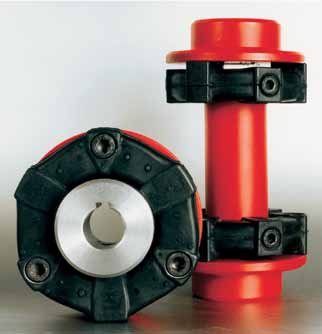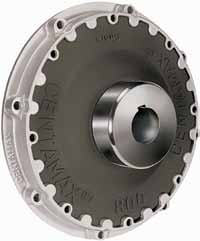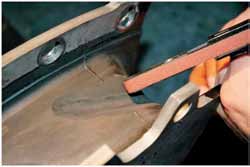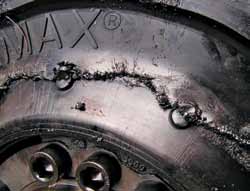Elastomeric couplings offer easy maintenance and lower bearing reaction forces.
Flexible couplings are available in a variety of designs, types and sizes. The basic function of the flexible coupling is to allow for the transmission of rotating torque while accommodating system misalignment between the driver and the driven equipment.
Static Versus Operating Alignment
Design and maintenance personnel (those specifying which coupling type to install) must understand the differences in misalignment between a system at rest and a system under operation. Performing a high quality alignment procedure on a system at rest is simple. However, a clear understanding of how the system will move under operation and under dynamic, loaded conditions is critical.

Figure 1. A typical rubber-in-compression coupling design
After understanding the load conditions of the equipment, personnel need to know how the coupling will respond to these conditions. Most flexible coupling catalogs state that a given coupling will accommodate some value of angular, radial and axial misalignments. However, they are rarely clear on how these values are interrelated and if they are for initial equipment alignment or operating conditions. The actual allowed values under operation are often lower than the static conditions.

Figure 2. A rubber-in-shear elastomeric coupling.
Arguments may be given as to why one couplingcan accommodate more misalignment than another, but engineers and maintenance personnel must understand the effect that the coupling has on the system under misalignment.
A flexible coupling under any level of misalignment induces bending loads into the connected shafts. These translate directly into radial and axial bearing loads. If too high, they can lead to bearing failure.
In practice, bearing failures are more common than coupling failures. Many believe that they have the proper coupling for their equipment and actually have few true coupling failures. The incidences of bearing failures, however, are another story. The bottom line is that poor flexible coupling choice and, inevitably, misalignment lead to many hours of expensive equipment downtime. This failure may be seen as bearing failure and not a coupling issue.

Figure 3. A typical rubber element crack and repair
The Benefits
Couplings can be metallic, lubricated or elastomeric. This article focuses on elastomeric couplings. Figure 1 shows a rubber-in-compression coupling. Figure 2 shows a rubber-in-shear elastomeric coupling. These couplings require little maintenance and no lubrication; are easy to install; and can damp shaft bending loads, transferring the energy into heat, through hysteresis, and keeping the load values away from the bearings.
One efficient elastomeric coupling design uses preloaded natural rubber under compression, (Figure 1). Rubber in compression is an effective method of torque transmission and accommodates shaft bending loads effectively. Rubber in compression couplings offer some of the lowest shaft reaction forces, translating into longer bearing life for the equipment.

Figure 4. Torsional failure
Troubleshooting
Rubber couplings also offer the simplest inspection and troubleshooting. When problems occur, they leave tell-tale signs. Properly selected and aligned, a rubber coupling can easily supply more than 40,000 hours of operational life expectancy. The primary factors that influence life expectancy include heat; grease; oil; and ultraviolet light, ozone and solvent exposures.
Generally, heat is the greatest enemy of an elastomeric coupling. It can build up from ambient environmental sources, misalignment induced shaft bending or torsional vibration activity if the system involves a reciprocating driver or driven equipment. Elastomeric couplings based on natural rubber elements also prefer to be kept in operation, as opposed to sitting in storage. This is due to the shelf life of rubber and the crosslinking (or hardening) that rubber naturally exhibits when left at rest. The constant working of the rubber allows a well-aligned rubber coupling to last for many years in operation, as opposed to about five years of storage life that is typical.
Maintenance
General maintenance inspection of rubber couplings involves a 2,500-hour interval of thorough visual inspection; a 5,000-hour interval of bolt torque inspection/recertification; and a 10,000-hour interval of complete coupling disassembly and visual inspection. When inspecting an elastomeric coupling, it is normal for the it to take an angular set (or twist) after time in operation. The outer surface of the elastomer may commonly exhibit minor hardening and light cracking. The coupling manufacturer should supply the proper guidelines for measuring and evaluating the maximum permissible angle of set/twist, and the crack measurements that would dictate replacement.
While not much can be done for an element that has exceeded its maximum allowable angle of set, an element that has developed a crack may be repaired in the field. Figure 3 shows a typical crack repaired with a belt sander.
The other failure mode sometimes encountered with reciprocating drives is torsional failure. In a classic torsional failure, the rubber element builds up excessive heat from the inside-out, and it literally melts the inside core of the rubber element. See Figure 4.
If equipment is driven by a high compression engine or if an electric motor system includes a variable frequency drive coupled to a reciprocating pump or compressor, it is a good idea to consult a qualified torsional vibration consultant to assure that the elastomeric coupling is properly selected to protect the system from harmful resonances. If a rubber coupling has melted from the inside, the problem must be addressed with qualified experts to ensure that the equipment can safely be restored to nominal operating conditions.
Conclusion
Flexible coupling maintenance issues can be subtle and difficult to diagnose. They generally manifest as bearing failures or shaft failures due to excessive bending loads generated by improper equipment alignment combined with poor coupling design choice. Selection of an elastomeric coupling can help increase system up-time and lower the cost of ownership.
Pumps & Systems, July 2011

